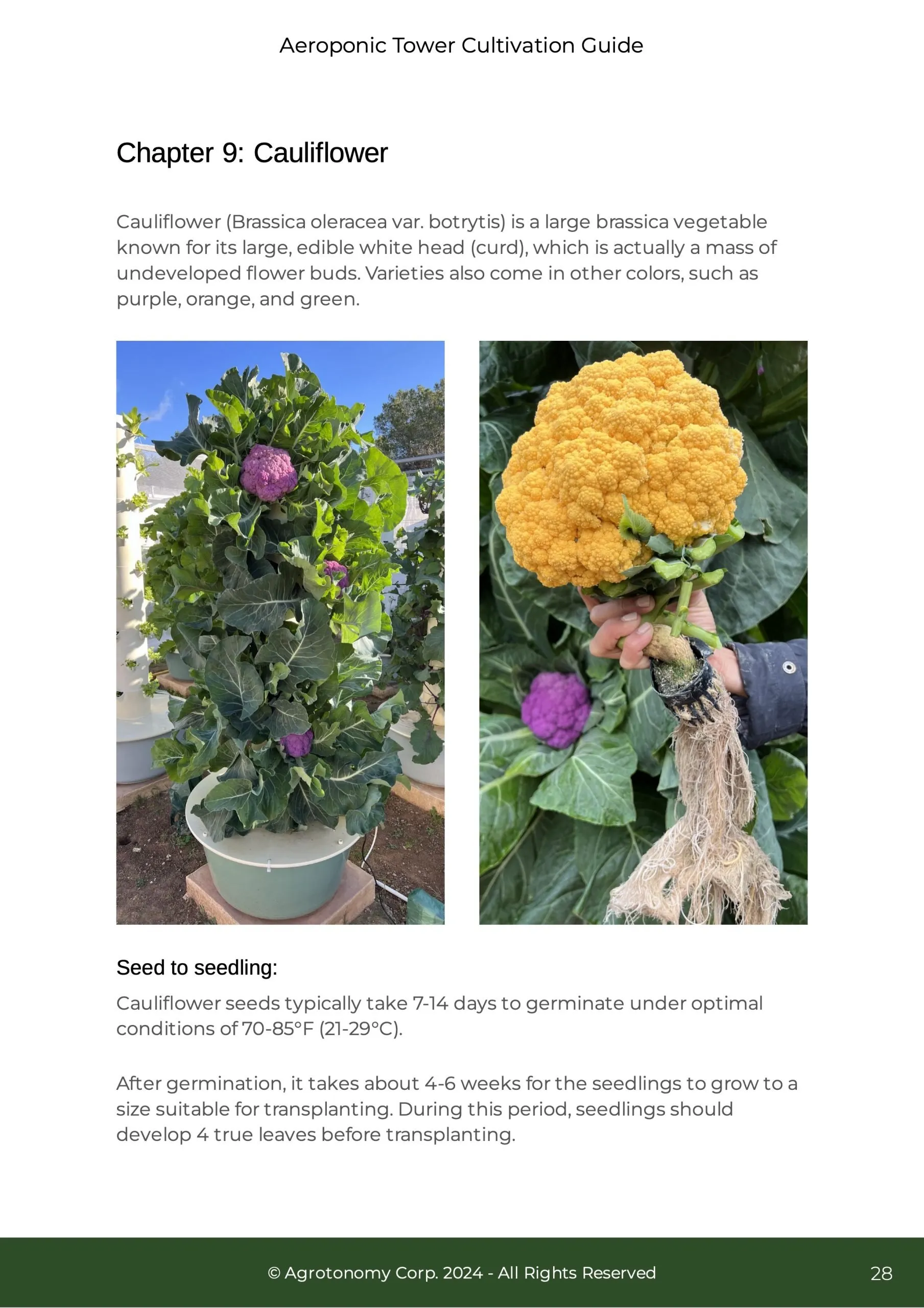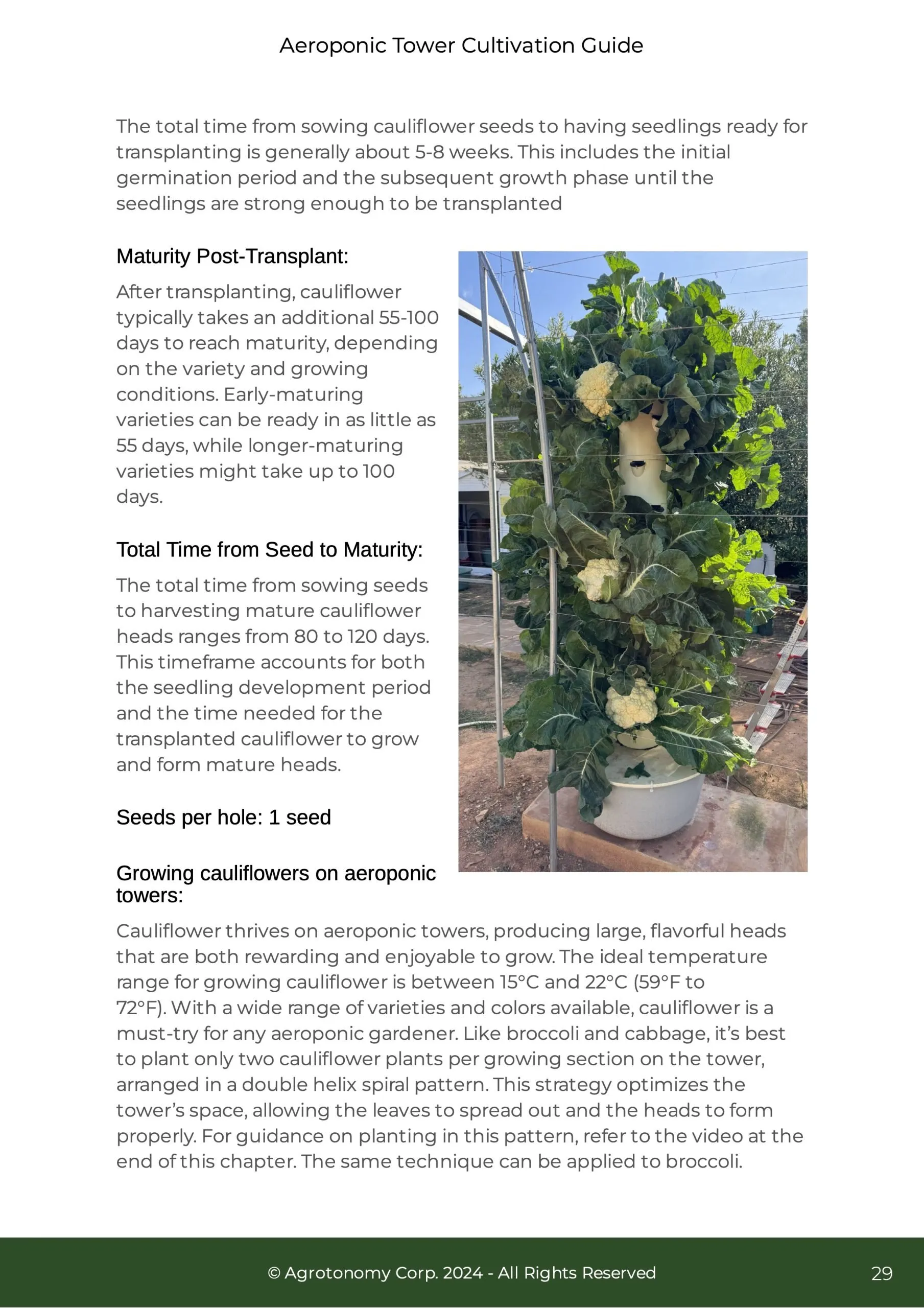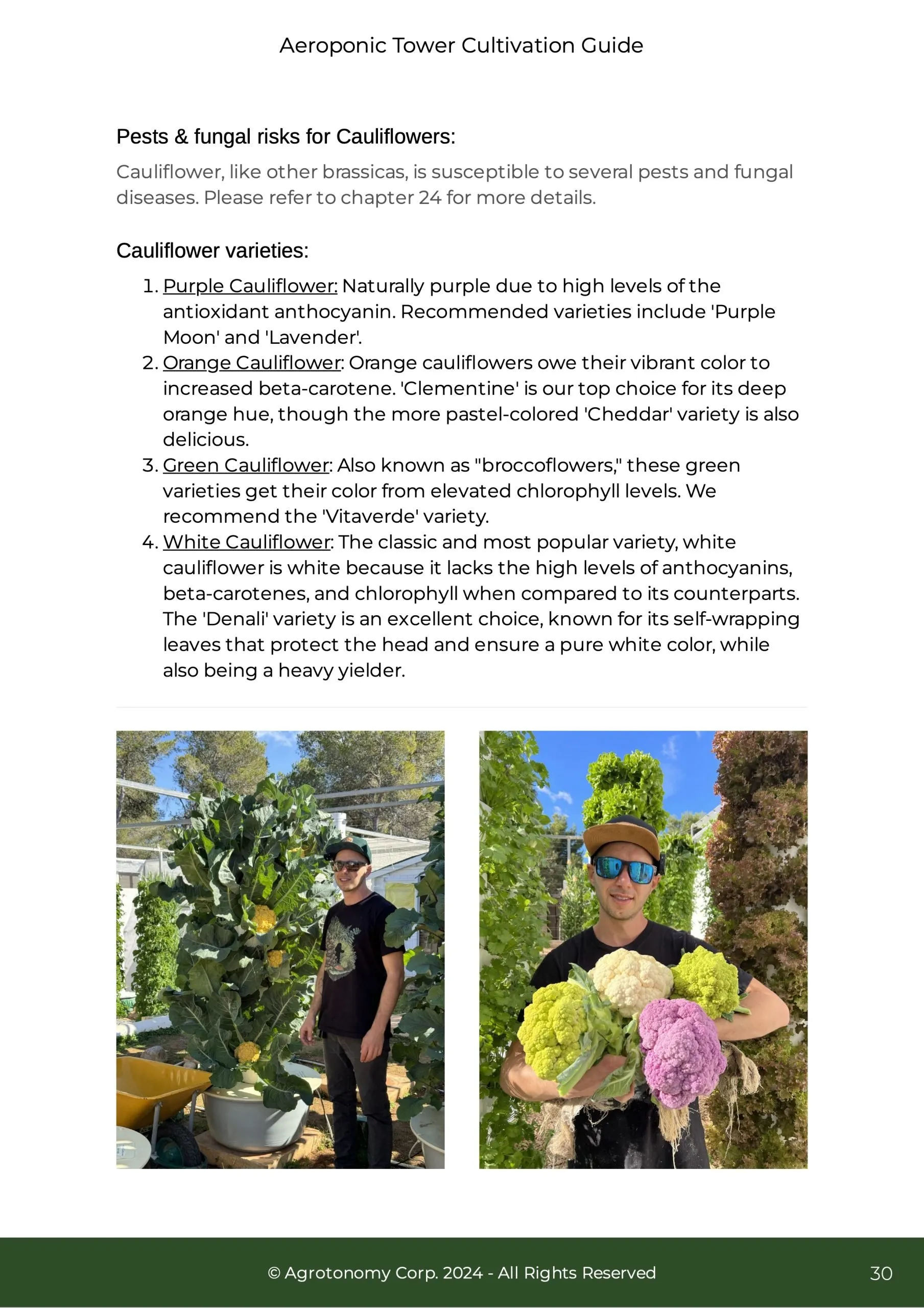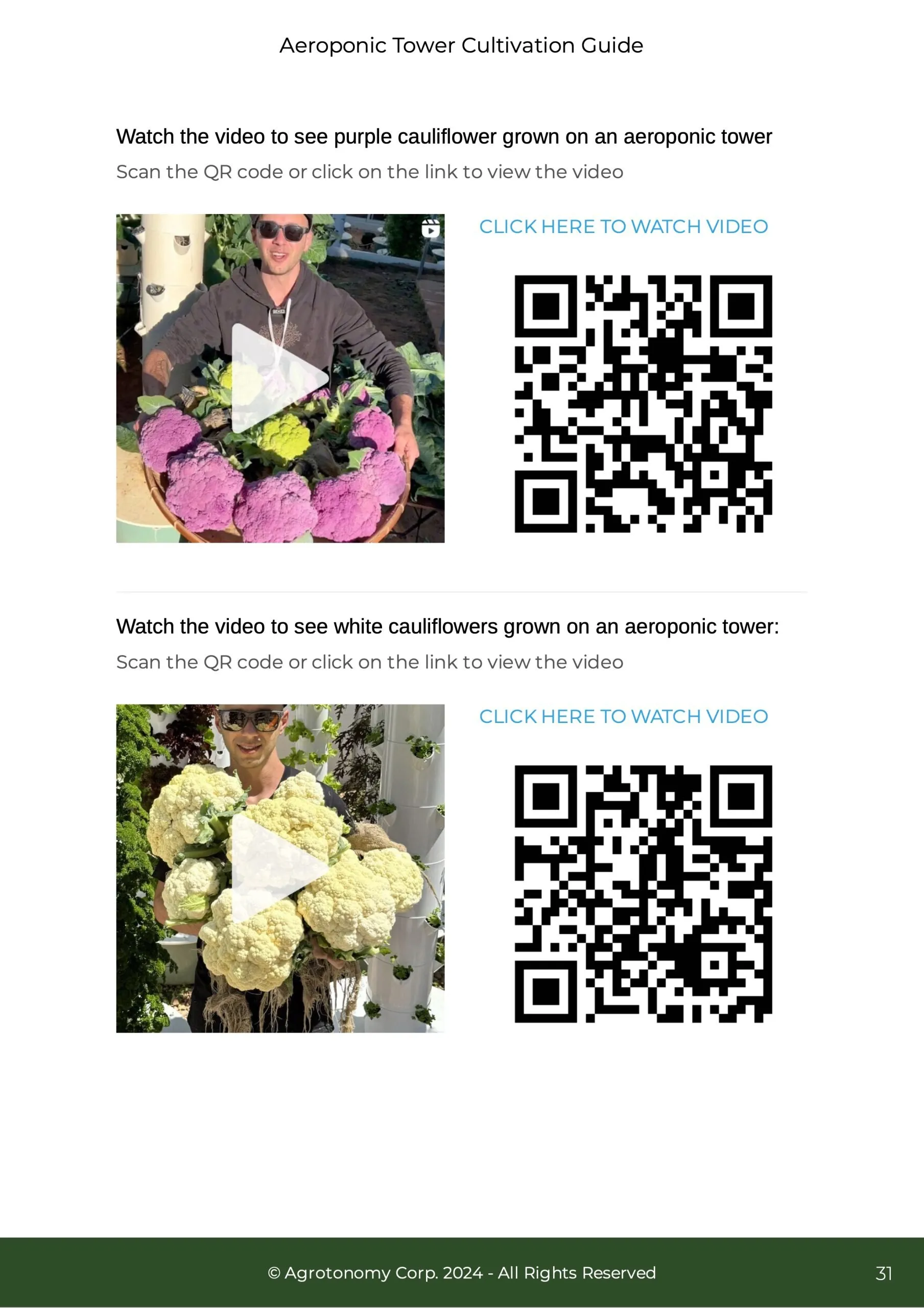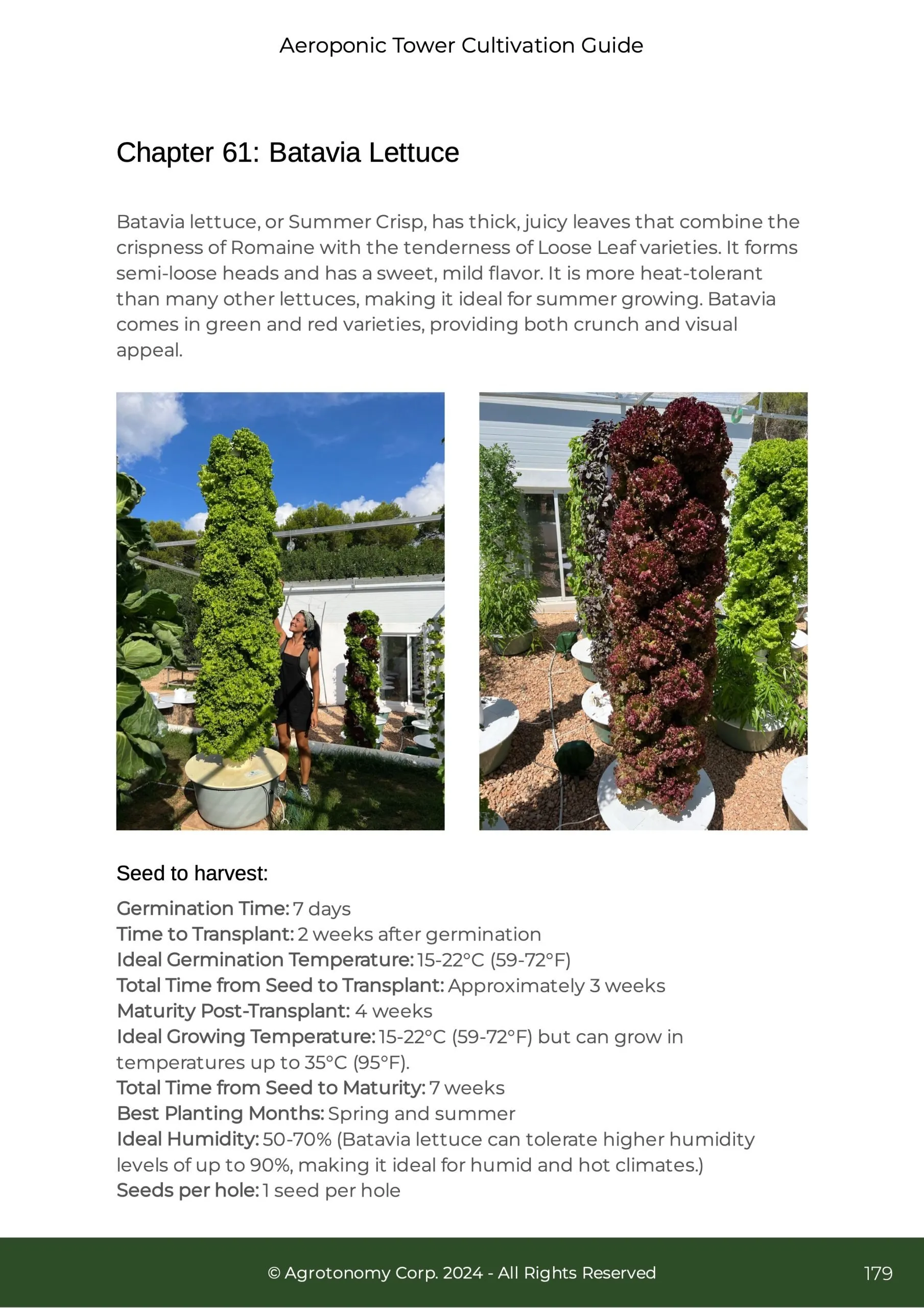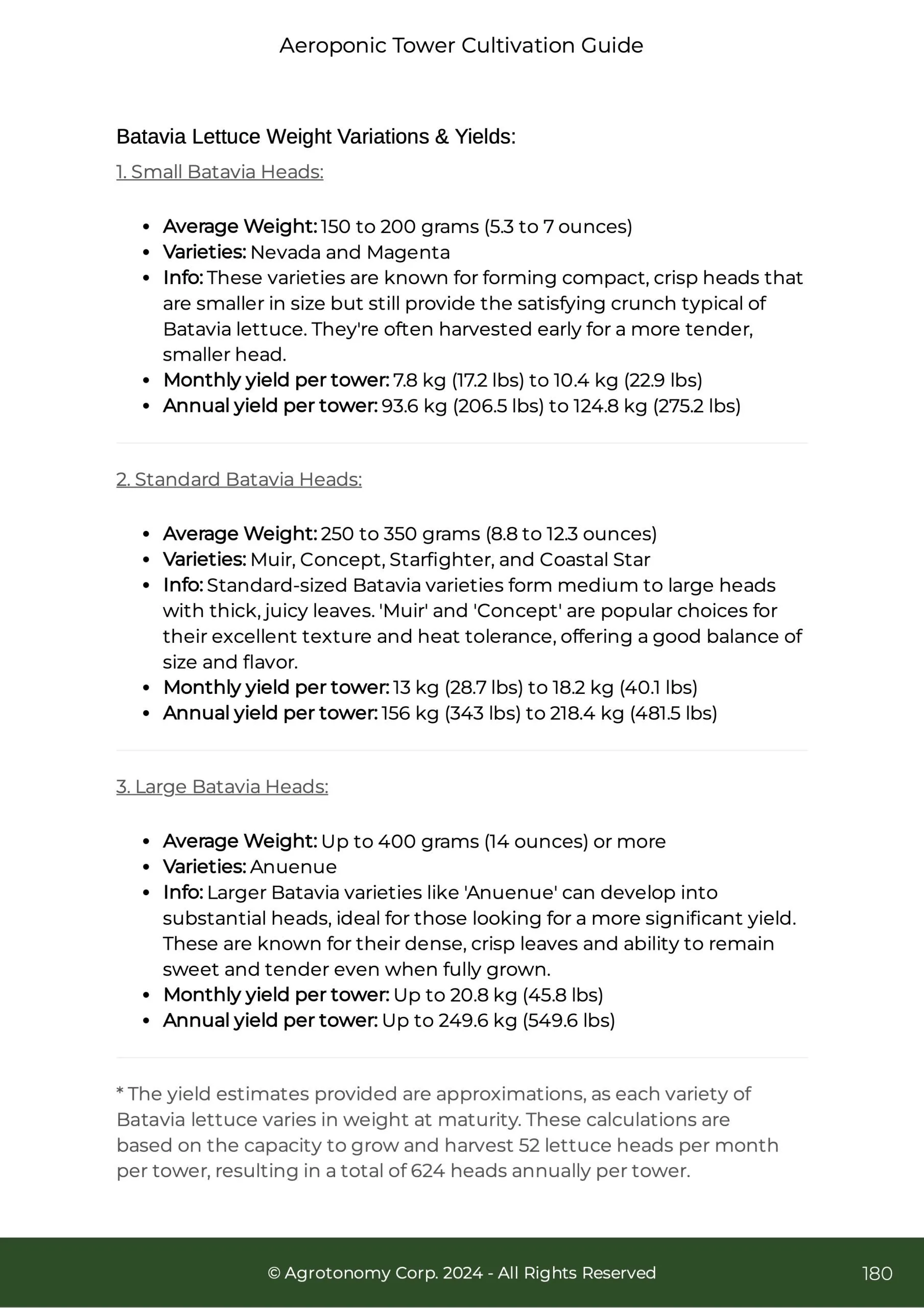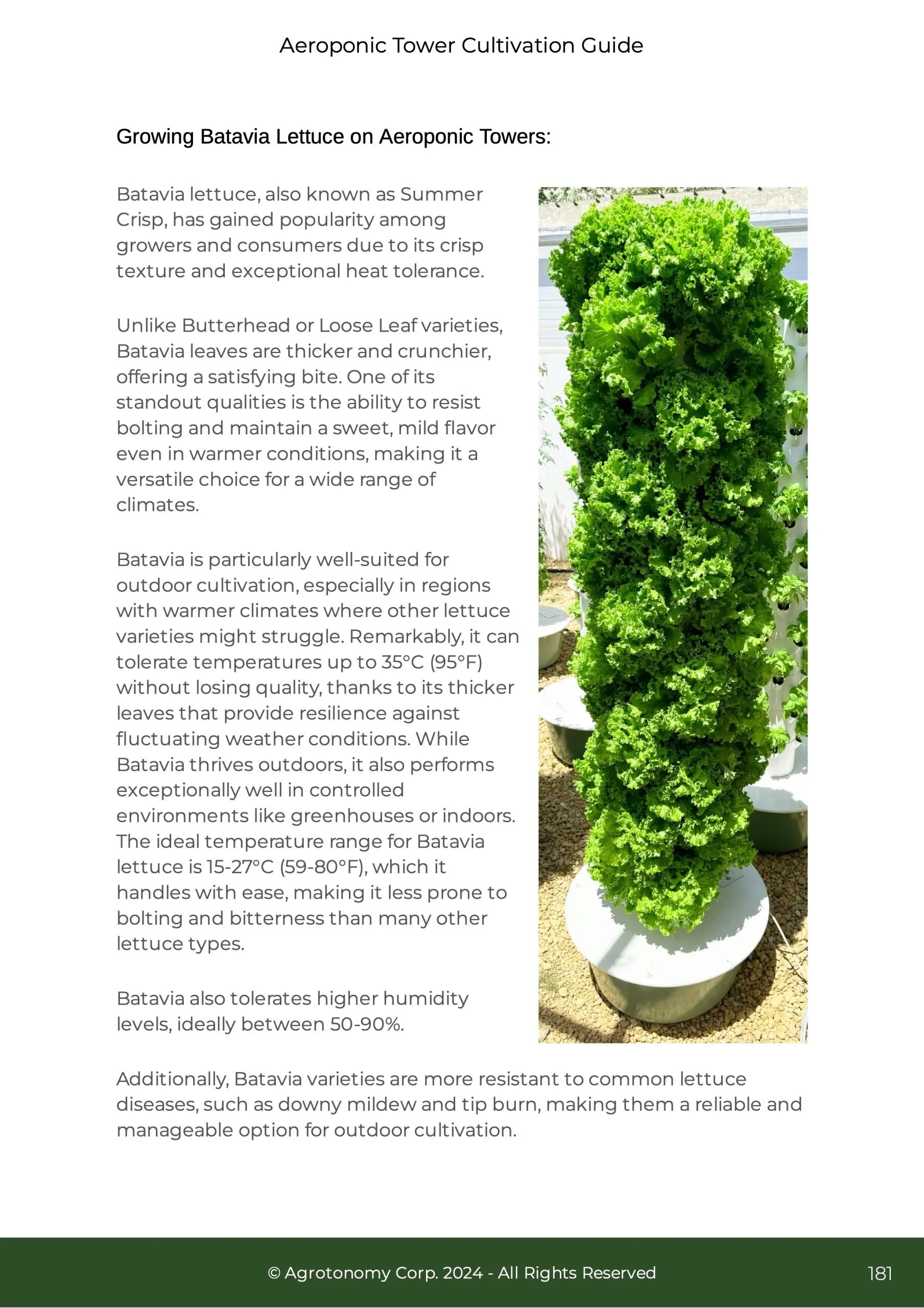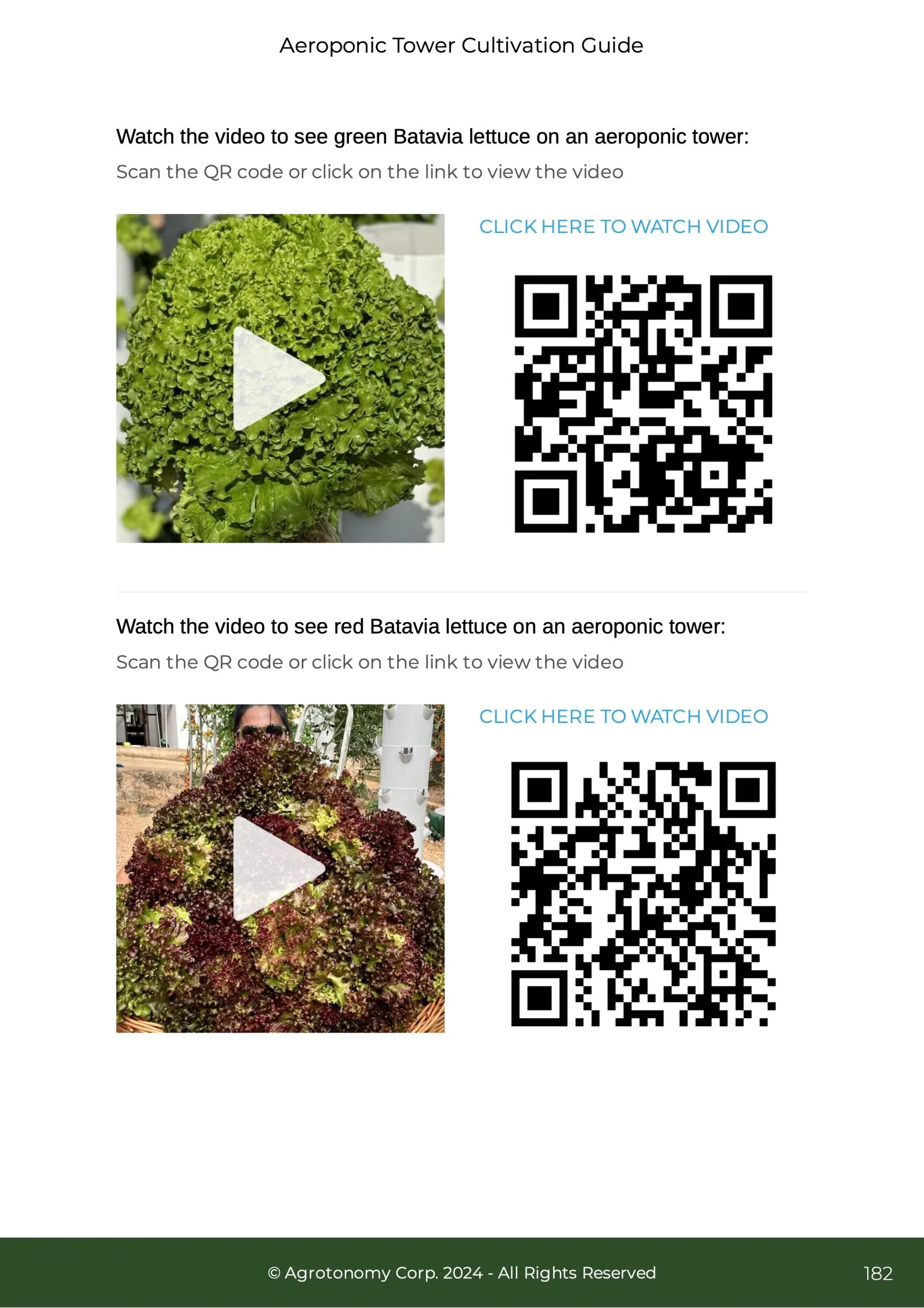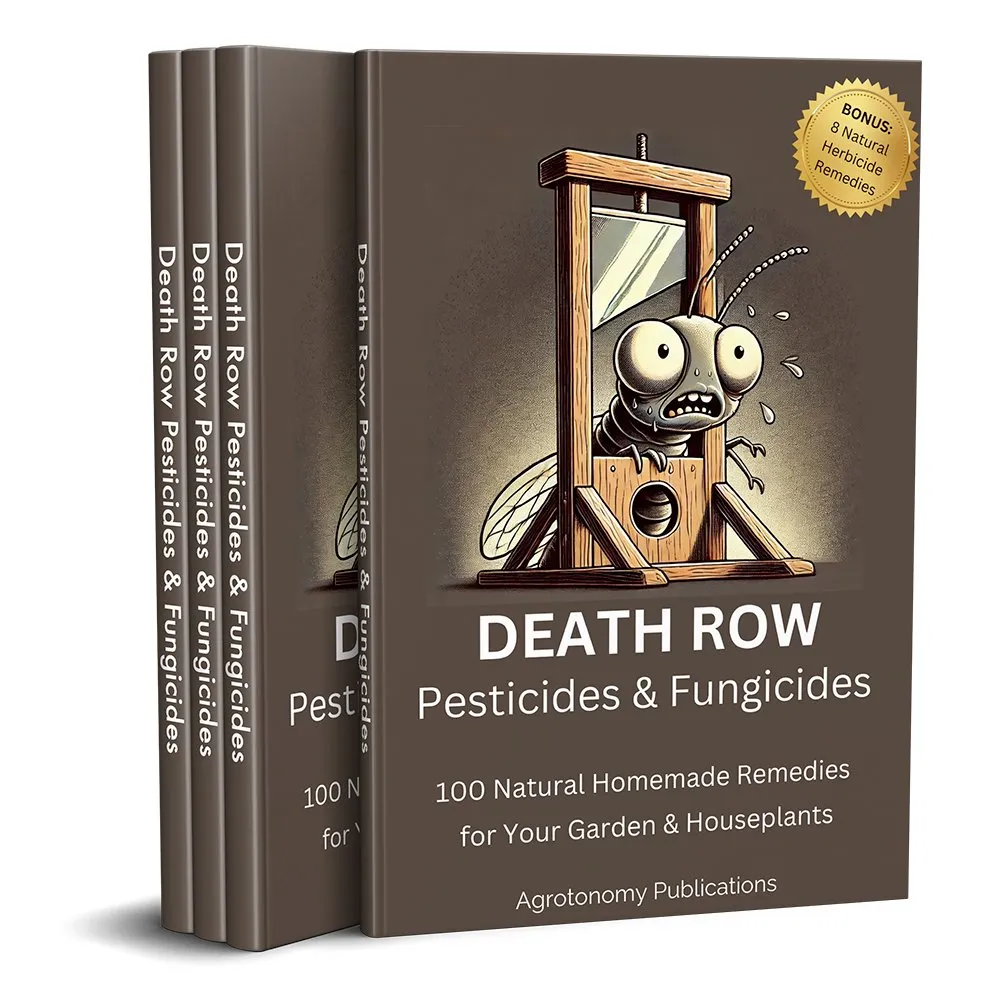Aeroponic Tower Cultivation Guide
$49.00
The Aeroponic Tower Cultivation Guide is a 275-page in-depth manual featuring 95 chapters, offering the most comprehensive resource for mastering growing crops on aeroponic towers—whether for home use or in a commercial setting.
Covering 75 crops, it provides precise details on everything from the number of seeds required per plant, to how long seedlings take to be ready for transplanting, and the time needed before harvesting. Each crop is accompanied by high-quality photos and exclusive videos, ensuring clear, practical guidance at every stage.
This guide doesn’t just focus on crops. It includes essential information on nutrient dosing, pH and EC management, algae control, greenhouse setups, solar energy solutions, and residential aeroponic systems.
Drawing from Agrotonomy’s vast experience across six continents, this guide delivers practical knowledge tailored to both beginners and experienced growers looking to optimize their aeroponic tower systems. Take your aeroponic tower growing skills to the next level with Agrotonomy’s hands-on expertise.
Preview of E-book
FAQs
1. In Which Format Will I Receive the Aeroponic Tower Cultivation Guide?
The Aeroponic Tower Cultivation Guide will be delivered to you via email as a password-protected PDF file.
2. Why Don’t We Publish a Printed Version as a Physical Book?
The Aeroponic Tower Cultivation Guide, which features 275 pages and 95 chapters, is continuously updated. As we experiment with new crops and refine our techniques, we regularly update the publication to include the latest successful practices. As a customer, you will receive these updated versions at no extra cost, which isn’t feasible with a printed edition.
What Is the Difference Between the Aeroponic Tower Cultivation Guide and Vertical Farming with Aeroponics?
The Aeroponic Tower Cultivation Guide focuses on enhancing your ability to grow crops on aeroponic towers. Covering 75 crops, it provides detailed guidance from seed requirements to seedling readiness for transplanting and harvest timelines. Each crop section includes high-quality photos and exclusive videos, offering clear, practical advice for home and commercial use.
Vertical Farming with Aeroponics, on the other hand, is the ultimate resource for anyone considering setting up a vertical farm using aeroponic towers. It provides comprehensive information on system configurations, technical specifications, shipping and MOQ details, reseller information, water and energy consumption, space allocation, nutrient quality and usage, labor, crop yield expectations, installation, training, irrigation, and nutrient dosing systems. This book is a must-have when planning a commercial project, as it contains all the essential information needed to write up a business plan.
4. What is the e-book table of contents?
Part 1: Allium Vegetables
– Chapter 1: Chives
– Chapter 2: Leeks
– Chapter 3: Spring Onions (Scallions & Green Onions)
Part 2: Brassica Vegetables
– Chapter 4: Arugula
– Chapter 5: Bok Choy
– Chapter 6: Broccoli
– Chapter 7: Brussel Sprouts
– Chapter 8: Cabbages
– Chapter 9: Cauliflower
– Chapter 10: Choy Sum
– Chapter 11: Collard Greens
– Chapter 12: Hon Tat Tsai
– Chapter 13: Kale
– Chapter 14: Kohlrabi
– Chapter 15: Komatsuna
– Chapter 16: Mizuna
– Chapter 17: Mustard Greens
– Chapter 18: Ornamental Kale
– Chapter 19: Radishes
– Chapter 20: Romanesco
– Chapter 21: Tatsoi
– Chapter 22: Tokyo Bekana
– Chapter 23: Turnips
– Chapter 24: Brassica Pests & Natural Solutions
– Chapter 25: Brassica Diseases & Natural Treatments
Part 3: Cucurbit Vegetables
– Chapter 26: Cucumbers
– Chapter 27: Cucamelons
– Chapter 28: Gourds
– Chapter 29: Kiwano
– Chapter 30: Melons & Watermelons
– Chapter 31: Summer Squash
– Chapter 32: Winter Squash
– Chapter 33: Cucurbit Fungal Diseases & Treatments
– Chapter 34: Cucurbit Pests and Natural Solutions
Part 4: Herbs
– Chapter 35: Basil
– Chapter 36: Chervil
– Chapter 37: Cilantro (Coriander)
– Chapter 38: Dill
– Chapter 39: Marjoram
– Chapter 40: Mint
– Chapter 41: Oregano
– Chapter 42: Parsley
– Chapter 43: Rosemary
– Chapter 44: Sage
– Chapter 45: Shiso
– Chapter 46: Sorrel
– Chapter 47: Tarragon
– Chapter 48: Thyme
Part 5: Flowers
– Chapter 49: Amaranth
– Chapter 50: Calendula
– Chapter 51: Celosia (cockscomb)
– Chapter 52: Chrysanthemum
– Chapter 53: Cosmos
– Chapter 54: Marigolds
– Chapter 55: Nasturtiums
– Chapter 56: Pansies & Violas
– Chapter 57: Stock Flowers
– Chapter 58: Sunflowers
– Chapter 59: Zinnias
Part 6: Lettuce
– Chapter 60: Butterhead Lettuce
– Chapter 61: Batavia Lettuce
– Chapter 62: Romaine Lettuce
– Chapter 63: Lollo Lettuce
– Chapter 64: Oak Leaf Lettuce
– Chapter 65: Iceberg Lettuce
Part 7: Nightshades
– Chapter 66: Eggplants (Aubergine)
– Chapter 67: Peppers
– Chapter 68: Tomatoes
Part 8: Goosefoot Family
– Chapter 69: Chard
– Chapter 70: Spinach
Part 9: Other Vegetables
– Chapter 71: Beans
– Chapter 72: Celery
– Chapter 73: Corn
– Chapter 74: Fennel
– Chapter 75: Kangkung (Water Spinach)
– Chapter 76: Okra
– Chapter 77: Red Malabar Spinach
– Chapter 78: Strawberries
Part 10: Tower Essentials & Operations
– Chapter 79: Submersible Pumps
– Chapter 80: Dosatron & Nutrient Dosing
– Chapter 81: Seed Quality & Selection
– Chapter 82: Grow Cages
– Chapter 83: pH (potential of hydrogen)
– Chapter 84: TDS (Total Dissolved Solids)
– Chapter 85: Reverse Osmosis Filtration
– Chapter 86: EC (Electro Conductivity)
– Chapter 87: Rock wool vs coco coir
– Chapter 88: Algae Growth on Aeroponic Towers
– Chapter 89: Bacterial Slime
– Chapter 90: Tower Cleaning Strategy
– Chapter 91: Seedlings
– Chapter 92: Electricity & Solar Energy
– Chapter 93: Greenhouses and Indoor Farming
– Chapter 94: Residential Aeroponic Tower for Home Use
– Chapter 95: Start Your Vertical Farm Today!



